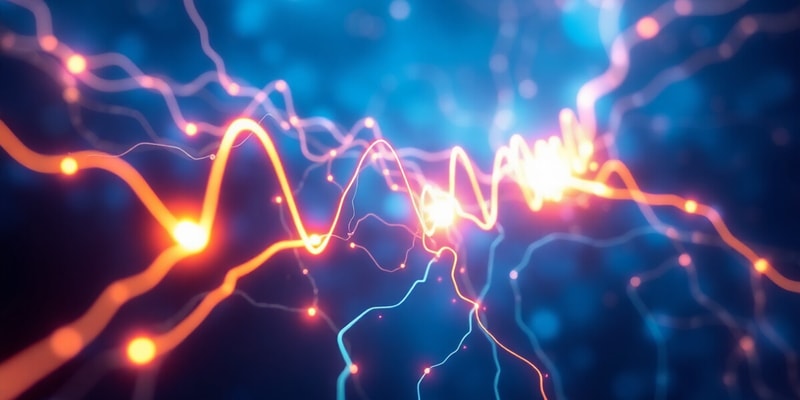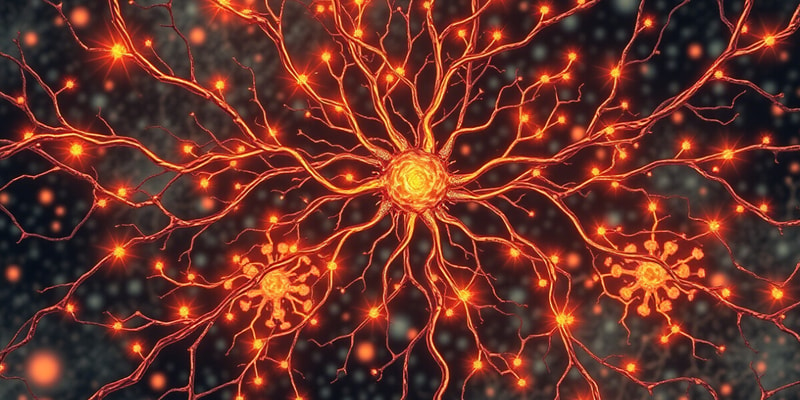Podcast
Questions and Answers
What happens to Na+ channel activity at the peak of an action potential?
What happens to Na+ channel activity at the peak of an action potential?
Na+ channels close at the peak of an action potential.
Explain why the efflux of K+ is rapid during repolarization.
Explain why the efflux of K+ is rapid during repolarization.
The efflux of K+ is rapid due to both a large K+ concentration gradient and a strong electrical gradient.
What is the role of the Na+/K+ pump following an action potential?
What is the role of the Na+/K+ pump following an action potential?
The Na+/K+ pump restores the resting membrane potential (RMP) after an action potential.
How does the myelin sheath influence action potential propagation?
How does the myelin sheath influence action potential propagation?
Signup and view all the answers
Describe the significance of the electrical gradient in the context of neuronal action potentials.
Describe the significance of the electrical gradient in the context of neuronal action potentials.
Signup and view all the answers
What is the resting membrane potential of a typical neuron?
What is the resting membrane potential of a typical neuron?
Signup and view all the answers
How fast does a nerve impulse travel in meters per second?
How fast does a nerve impulse travel in meters per second?
Signup and view all the answers
What is the speed of nerve impulses compared to copper wire?
What is the speed of nerve impulses compared to copper wire?
Signup and view all the answers
How much slower is diffusion than nerve impulse transmission?
How much slower is diffusion than nerve impulse transmission?
Signup and view all the answers
What is the speed of diffusion in kilometers per hour?
What is the speed of diffusion in kilometers per hour?
Signup and view all the answers
What is the equivalent distance traveled by a nerve impulse in an hour?
What is the equivalent distance traveled by a nerve impulse in an hour?
Signup and view all the answers
What ion's movement is primarily responsible for initiating a nerve impulse?
What ion's movement is primarily responsible for initiating a nerve impulse?
Signup and view all the answers
What is the maximum potential reached during a nerve impulse depolarization?
What is the maximum potential reached during a nerve impulse depolarization?
Signup and view all the answers
How does the speed of nerve impulses compare to that of a typical physical object?
How does the speed of nerve impulses compare to that of a typical physical object?
Signup and view all the answers
In terms of physiological importance, why is the speed of nerve impulses significant?
In terms of physiological importance, why is the speed of nerve impulses significant?
Signup and view all the answers
How does the brain differentiate between similar action potentials from different stimuli?
How does the brain differentiate between similar action potentials from different stimuli?
Signup and view all the answers
What role do neurotransmitters play in sensory cell signaling?
What role do neurotransmitters play in sensory cell signaling?
Signup and view all the answers
Explain how graded potentials can affect the generation of action potentials.
Explain how graded potentials can affect the generation of action potentials.
Signup and view all the answers
Why is the directional propagation of action potentials crucial in neural communication?
Why is the directional propagation of action potentials crucial in neural communication?
Signup and view all the answers
What is the effect of not reaching the threshold of -55 mV in a sensory neuron?
What is the effect of not reaching the threshold of -55 mV in a sensory neuron?
Signup and view all the answers
Describe the process that occurs when an action potential arrives at the nerve terminal.
Describe the process that occurs when an action potential arrives at the nerve terminal.
Signup and view all the answers
Discuss the significance of sensory cells in the nervous system.
Discuss the significance of sensory cells in the nervous system.
Signup and view all the answers
What happens during the activation of gated Na+ channels in sensory cells?
What happens during the activation of gated Na+ channels in sensory cells?
Signup and view all the answers
What phenomenon occurs when a sensory cell is at its resting membrane potential?
What phenomenon occurs when a sensory cell is at its resting membrane potential?
Signup and view all the answers
What does low frequency of action potentials indicate about neurotransmitter release?
What does low frequency of action potentials indicate about neurotransmitter release?
Signup and view all the answers
What is the significance of the 'medium' frequency of action potentials?
What is the significance of the 'medium' frequency of action potentials?
Signup and view all the answers
How does a high frequency of action potentials affect neurotransmitter activity?
How does a high frequency of action potentials affect neurotransmitter activity?
Signup and view all the answers
What are action potentials fundamentally characterized by?
What are action potentials fundamentally characterized by?
Signup and view all the answers
Explain the role of neuroglia in the propagation of action potentials.
Explain the role of neuroglia in the propagation of action potentials.
Signup and view all the answers
What determines whether a graded potential can lead to an action potential?
What determines whether a graded potential can lead to an action potential?
Signup and view all the answers
How does synaptic transmission occur by diffusion?
How does synaptic transmission occur by diffusion?
Signup and view all the answers
What is the time it would take for ion diffusion to achieve equilibrium over 1µm in a nerve?
What is the time it would take for ion diffusion to achieve equilibrium over 1µm in a nerve?
Signup and view all the answers
Describe the role of sensory cells in the nervous system.
Describe the role of sensory cells in the nervous system.
Signup and view all the answers
What is the significance of reaching -55 mV in the context of graded potentials?
What is the significance of reaching -55 mV in the context of graded potentials?
Signup and view all the answers
How do graded potentials affect the membrane potential before triggering an action potential?
How do graded potentials affect the membrane potential before triggering an action potential?
Signup and view all the answers
What role do voltage-gated Na+ and K+ channels play in action potentials?
What role do voltage-gated Na+ and K+ channels play in action potentials?
Signup and view all the answers
Explain why the resting membrane potential is typically around -70 mV.
Explain why the resting membrane potential is typically around -70 mV.
Signup and view all the answers
What happens to the membrane potential when Na+ channels open at -55 mV?
What happens to the membrane potential when Na+ channels open at -55 mV?
Signup and view all the answers
Describe how graded potentials can lead to action potentials.
Describe how graded potentials can lead to action potentials.
Signup and view all the answers
Why is immediate repolarization important after an action potential?
Why is immediate repolarization important after an action potential?
Signup and view all the answers
What determines the amplitude and duration of a graded potential?
What determines the amplitude and duration of a graded potential?
Signup and view all the answers
How does the influx of Na+ ions influence the overall behavior of a neuron?
How does the influx of Na+ ions influence the overall behavior of a neuron?
Signup and view all the answers
What would happen if the threshold potential of -55 mV were not reached?
What would happen if the threshold potential of -55 mV were not reached?
Signup and view all the answers
Study Notes
Nerve Impulses
- The brain differentiates between stimuli due to nerve endings terminating in different brain regions.
- Sensory cells generate graded potentials upon stimulation, leading to graded release of neurotransmitters.
- Neurotransmitters (NTs) released from the pre-synaptic cell diffuse a short distance to the post-synaptic cell.
- NT receptors on the nerve cell body generate graded potentials at the axon hillock.
- If the threshold of -55 mV is not reached, nothing happens.
- If the threshold of -55 mV is reached, a low frequency of action potentials is generated and propagated along the axon.
- Maintaining the threshold of -55 mV results in a high frequency of action potentials being generated and propagated along the axon.
- The arrival of action potentials triggers NT release and binding to other nerve cells.
Nerve Impulse Generation
- The activation of gated Na+ channels on the surface of sensory cells causes rapid Na+ influx.
Action potentials
- Action potentials are rapid changes in membrane potential.
- Action potentials rely on the opening and closing of voltage-gated Na+ and K+ channels in the axon.
Nerve impulse timing
- A nerve impulse can travel 1 meter in 1/100 of a second.
- The speed of nerve impulses is 360 km/h.
- Copper wire is 3 x 10^6 times faster than a nerve impulse, while diffusion is 4 x 10^10 times slower.
Graded Potentials
- Graded potentials can work by diffusion because they travel short distances within a cell.
Action Potential Mechanism
- The resting membrane potential is -70 mV.
- The influx of Na+ due to the opening of Na+ channels rapidly increases membrane potential to +30 mV.
- Na+ channels close when the peak of the action potential is reached.
- The opening of K+ channels at +30 mV results in a rapid efflux of K+ and decreases membrane potential to –90 mV.
- The Na+/K+ pump helps reset the membrane potential to -70 mV.
Studying That Suits You
Use AI to generate personalized quizzes and flashcards to suit your learning preferences.
Related Documents
Description
This quiz covers the fundamentals of nerve impulses, including how the brain processes stimuli through nerve endings and the role of neurotransmitters in signal transmission. Learn about graded potentials and the conditions required for generating action potentials. Test your understanding of these essential concepts in neuroscience.




